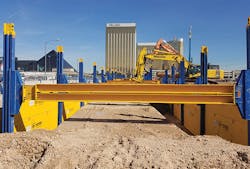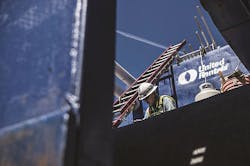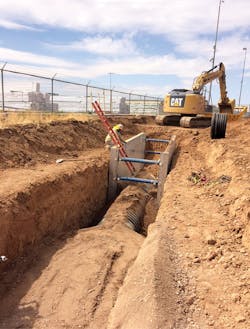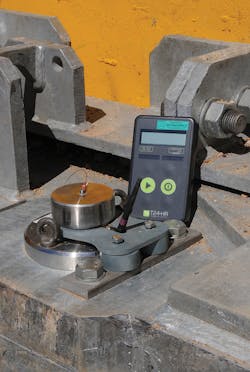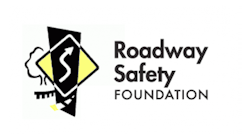Everyone has a set of safety numbers for trenching activity. According to the Bureau of Labor Statistics, the construction industry suffered 97 trenching fatalities between 2013–2017. Altering the date range slightly to 2011–2016, the Occupational Safety and Health Administration, an agency of the US Department of Labor, counts 130. Private construction accounted for 80% of those, and an additional 49% of fatalities in 2015–2016. Fatalities happen most in residential jobs, not commercial or industrial jobs.
Figures supplied by United Rentals indicate a high count of 36 deaths in 2016. Numbers aren’t in for 2019 yet, but by April, OSHA was already busy investigating five trenching deaths in three different states that occurred in just a fortnight.
Citing an upward trend in fatalities, UR’s Albie Jarvis believes that “contractors have compelling reasons to take trench safety seriously.”
OSHA thinks so too. Not only did they institute the Emphasis on Safety program last year, but OSHA also partnered with the North American Excavation Shoring Association and other industry and trade associations to promote Trench Safety Summits. “These have been well received by contractors and public agencies,” states Ron Chilton, president of National Trench Safety LLC. Free to contractors and public agency employees, these seminars feature classroom training and hands-on demonstrations and are sponsored by companies such as NTS.
Equipment
Shoring equipment has been evolving over the years to become lighter, stronger, and generally easier to install safely from aboveground without exposing workers to potentially dangerous working conditions.
Designs are increasingly more efficient, lighter, and stronger, agrees Patrick Sweeney, director of the shoring solutions division for Sunbelt Rentals, and tend to incorporate more aluminum. “Smaller contractors can’t move the heavier steel boxes because they lack heavy equipment. Aluminum is easier to haul.”
While much of the aluminum equipment can “get close to the same depth ratings,” Sweeney says smaller private contractors work in the range of 5- to 12-feet-deep excavations, “where aluminum is fine.”
Lighter, faster, cheaper equipmentis easier to use. One safety innovation is adjustability. “The boxes fold out and fold together,” explains Sweeney.
Modular systems such as slide rail systems and modular aluminum panel shields, along with safety accessories including engineered guard rails and confined space emergency rescue equipment designed for the equipment being used, make for a safer and more productive work environment for all, Chilton believes.
Today’s equipment is better engineered, more efficient, lighter, easier to handle, and easier to install, contends Tom Hartman, senior vice president of strategic alliances for National Trench Safety LLC. It’s also focused on safety, from the warning signs for vehicular traffic to ladders and ladder access platforms for safe ingress and egress to slide rails with handrails. “We needed something that clamps and works with our product.” NTS’s slide rails have been engineered and tested to OSHA specifications for the load.
Hartman discusses active and passive loads. “When you dig a trench, you have an open hole while you’re waiting on the workers. If you’re not protecting things nearby, like utilities, the road, the landscaping, it can collapse and cause property damage.”
Big hammers that drive the pilings for sheeting are tall and can be a danger around overhead utility lines. Vibration can cause damage to structures in the vicinity of the work. “Our main safety is to protect the workers,” says Hartman, “but our ancillary safety is to protect structures.” He suggests a slide rail, which is a hybrid between driving sheets and installing a trench box because it exerts less impact on things around the hole as it goes in one piece at a time. “Installation is easier and requires smaller equipment.” Steel and aluminum trench shields add additional protection for workers.
Training and Education
OSHA has a long list of safety rules for trenching operations. In addition to keeping data and a job site checklist on the premises, OSHA requires the designation of a competent person to classify soil, choose an appropriate protective system if needed, identify potential hazards, and conduct inspections. The person must have the authorization to take prompt corrective measures to eliminate any identified hazards.
“The single most important measure for preventing cave-ins when working in trenches is designating a competent person and making sure that person is adequately trained,” says Joe Wise, regional customer training manager, Trench Safety, at United Rentals. That one simple step can make trench and excavation work less hazardous.
Sondergard suggests that selecting the proper shoring to meet the job site conditions is the most important safety aspect, but that having a qualified, competent person onsite to perform soils analysis and daily inspections is critical to excavation safety. “In addition to their knowledge of the OSHA standard, the competent person must also understand tabulated data. For example, if the weight of the shielding or shoring system exceeds the lifting capacity of the machine on the site or the protective system is not large enough to properly protect the workers, there is a good chance the shielding or shoring will not be used, creating a significant hazard.” He says everything should be planned around the proper protective system (slope, shield, shoring) and site conditions, right-of-way, adjacent structures, traffic, and existing utilities.
Companies that “run afoul” of OSHA’s trench and excavation regulations risk being fined or even shut down, Jarvis says.
Enforcement is not where you want to put the emphasis, Sweeney interjects. “You want to emphasize training and community awareness. The OSHA directive from October 2018 calls out our industry.” He believes the outlined set of procedures and outreach programs intended to compel contractors to be proactive about safety “put more attention on the market.”
As a result, groups like NAXSA focus on incidents, training, and proper techniques to better protect workers and the property (including buildings, cars, and pedestrians) around a site. So do rental houses like Sunbelt, which offers training classes at all their locations. “Staff goes over the assembly with rental customers,” says Sweeney, “and site techs can go to the site to coach, mentor, and advise if necessary.” He says they’ve worked to improve their training, methodology, and equipment.
Similarly, Brett Sondergard, United Rentals district manager, says United Rentals’ United Academy Learning Management System makes it “very easy for contractors to keep and maintain safety training certifications.” With this system, employers and employees have access through a desktop or app to all their training records. ”Utilizing the benefits of an LMS system like United Academy not only gives users greater visibility to existing training records, but also access to over 400 safety courses delivered in Spanish, French, and English as an online, blended, or instructor-led format.”
Trench collapses are preventable, insists Sondergard. “A properly shored trench creates a safer work area, while one that is improperly shored creates an extremely dangerous condition.” He credits the availability and versatility of shoring equipment as the biggest advancements the industry has seen and says that educational classes to meet the OSHA requirements of training have contributed to more compliant excavation sites. “As we see advancements in technology, we will continue to make investments to enhance our worker safety training programs—not only for today but for the next generation of skilled labors.”
“The challenges of trenching and excavation job site safety are something companies face every day,” observes Todd Hayes, regional vice president, Trench Safety, United Rentals. “Everyone working at these sites needs to be knowledgeable about trench safety practices.” Anyone deemed a competent person needs to know the information, but it’s prudent for everyone in the trenches to brush up on safety requirements.
One beneficial aspect of the construction industry, Hartman considers, is that it gets a lot of attention because most work is done in public areas and right-of-ways. “Inspectors can see the work without needing permission; it’s high profile.” Decrying ignorance as being the biggest struggle, he emphasizes the importance of communication and says, “Training is a big part of our business. We have a dedicated department.”
Engineering
Training is specific and can be mandatory for some jobs. Many excavations are engineered, which requires specialized training. In the early days, engineering was performed by a third party, Hartman recalls. Now, most companies have a dedicated department to review plans.
“You need to understand soil type, water, dewatering, depth, inward pressures, and stresses,” lists Sweeney. He prefers using trench boxes. “Sometimes you can use vertical shores and shields, but for larger trenches or deep excavations, you need more sophisticated sheets and frames. Slide rail systems work well.”
As underground projects continue to increase in scope, depth, and complexity, the benefits of a site-specific trench safety engineering plan have never been more pronounced, Chilton believes. “While OSHA requirements mandate a site-specific trench safety plan stamped by a Registered Professional Engineer in some circumstances, there are also productivity benefits to exploring the use of an engineered site-specific plan on many projects that fall outside the OSHA requirement.”
The NTS engineering division plays a dual role in the design and development of new trench safety products and accessories. One such product is their proprietary “Telemetric Pin.” Every connection or hinge point requires a pin. The Telemetric Pin is designed to provide real-time monitoring on loads imposed on a shoring system by replacing one of the connecting pins in various shoring systems, such as hydraulic bracing or slide rail systems. Data on loads is crucial information. “If [the excavation is] near water, the load changes with the tide, so it’s important to monitor.” He says the pin works with a laptop or cell phone to remotely monitor the load.
Common Sense and Resistance to Change
The standard hasn’t changed, Sondergard believes. “The same requirements exist today as they did before the emphasis program.” What’s different is more outreach and more focus on excavations by OSHA as a result of the program.
Common sense goes hand-in-hand with regulation. Don’t cut corners, Sweeney advises. “A trench box rents for dollars a day—it’s not big money; it’s fractional compared with the job…and it saves lives.” He believes that economics should not be a factor at that level and says the cost “doesn’t move the needle,” but the cost could be included in the bid if it’s a concern.
Taking safety precautions and using equipment to protect workers in trenches should be routine. “It’s just like Personal Protection Equipment,” continues Sweeney. “You can’t walk onto a site without safety helmets, glasses, and boots. The same should be true of trenching and shoring equipment; it must become more routine, not just because it’s required.”
Companies want to take care of their workers, but there is a lingering resistance to safety regulations. Some of it is rooted in financial considerations: it costs money to be safe. But part of it is inertia, Sweeney says. “It takes education and behavior modification to get past the ‘We’ve always done it this way’ mentality.” The UK has a mandate, he says. “If you’re digging, you must have safety equipment in the hole or face fines, possibly lose your license.” OSHA is not at the point of mandating yet, but he insists that contractors “just have to do it—cross that chasm.”
Forging Ahead
“The number of accidents and deaths is small, but they are serious,” states Hartman. “People will always have to enter trenches for repairs and maintenance.” When they do, he envisions them working with safety equipment that continues to become lighter, easier to install, and even automatic. “I think you’ll see electric equipment.”
Lighter weight equipment can be strong if it’s made of composites, which is what Sweeney thinks will become the norm, possibly even for vertical shoring and trench crossing piece road plates. “You have to understand the nuances of each application. This isn’t a one-size-fits-all industry; it’s a specialty business and [contractors] should have a suite of products and services available.”
Companies can dig themselves out of unnecessary danger by following proper safety procedures and installing appropriate protective systems when necessary, Jarvis says. “Even in the face of all-too-real time and cost constraints, it pays to play it safe.”
